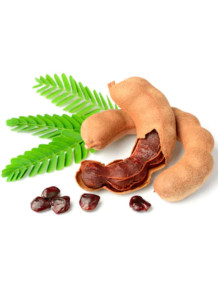Tamarind Gum (tamarind gum from tamarind seeds)
- Product Code: 9172
Provides a viscous (gelling agent) in food.
- -
- -
- -
- -
- -
- -
- -
- -
- -
- -
- -
- -
- -
- -
- -
- -
- -
- -
| Test Name | Specification |
|---|---|
| Color | Creamy-white |
| Fineness: Pass 100 Mesh | 100% |
| Fineness: Pass 200 Mesh | 99.99% Min |
| Moisture | 10% Max |
| Ash Content | 3.5% Max |
| Protein | 15-19% |
| Crude Fiber | 1% Max |
| Oil Content | 0.42% Max |
| pH Value | 6-8 |
| Insoluble Residue | 1.10% Max |
Tamarind Gum (Tamarind Gum from Tamarind Seeds)
Provides a viscous (gelling agent) in food.
Tamarind seed gum—also known as tamarind kernel powder—is produced by dehulling and milling the seeds of Tamarindus indica, yielding a fine powder rich in the neutral polysaccharide xyloglucan, which forms clear, viscous solutions at low concentrations. This xyloglucan network imparts unique functional properties—excellent thickening and stabilizing capacity, film-forming ability, and resistance to heat, acid, salt, and freeze–thaw cycles—making it a highly versatile hydrocolloid for food applications.
Thickening & Stabilizing
Tamarind gum is widely used to control viscosity and stabilize dispersions in sauces (e.g., ketchup, mustard), dressings, soups, and instant foods such as noodles and dairy desserts like ice cream. Its shear-thinning behavior delivers a smooth mouthfeel, while its stability under varying temperatures and pH conditions suits both hot- and cold-processed foods.
Gelling & Texture Modification
It can replace or complement pectin in jams, jellies, and confectionery to achieve tailored gel strength and minimize syneresis in low-sugar or acidic matrices. In gluten-free baking—particularly rice breads—tamarind gum enhances dough binding and crumb structure without off-flavors, demonstrating performance on par with or superior to HPMC, guar gum, and xanthan gum.
Emulsification & Freeze–Thaw Stability
As an emulsifier, tamarind gum improves the stability of oil-in-water systems in dairy products (e.g., flavored milks, cottage cheese), salad dressings, and processed meats by promoting uniform fat dispersion and preventing phase separation. Moreover, its superior freeze–thaw resistance helps maintain texture and prevent ice crystal growth in frozen desserts and ready-to-eat meals, matching or exceeding the performance of xanthan and guar gums in viscosity retention and syneresis prevention.
Edible Films & Coatings
Beyond direct inclusion in formulations, tamarind mucilage can be cast into edible films and coatings for fresh produce and cheese, forming transparent, flexible layers that act as barriers to moisture and oxygen—thereby extending shelf life and preserving quality. Its film-forming and bioadhesive properties make it a promising, sustainable alternative to synthetic packaging materials in active and intelligent food-packaging systems.
Be the first to review this product :-)
Recommend Lab-Service
| Lab Service | Price |
|---|
Provides a viscous (gelling agent) in food.
Tamarind Gum (Tamarind Gum from Tamarind Seeds)
Provides a viscous (gelling agent) in food.
Tamarind seed gum—also known as tamarind kernel powder—is produced by dehulling and milling the seeds of Tamarindus indica, yielding a fine powder rich in the neutral polysaccharide xyloglucan, which forms clear, viscous solutions at low concentrations. This xyloglucan network imparts unique functional properties—excellent thickening and stabilizing capacity, film-forming ability, and resistance to heat, acid, salt, and freeze–thaw cycles—making it a highly versatile hydrocolloid for food applications.
Thickening & Stabilizing
Tamarind gum is widely used to control viscosity and stabilize dispersions in sauces (e.g., ketchup, mustard), dressings, soups, and instant foods such as noodles and dairy desserts like ice cream. Its shear-thinning behavior delivers a smooth mouthfeel, while its stability under varying temperatures and pH conditions suits both hot- and cold-processed foods.
Gelling & Texture Modification
It can replace or complement pectin in jams, jellies, and confectionery to achieve tailored gel strength and minimize syneresis in low-sugar or acidic matrices. In gluten-free baking—particularly rice breads—tamarind gum enhances dough binding and crumb structure without off-flavors, demonstrating performance on par with or superior to HPMC, guar gum, and xanthan gum.
Emulsification & Freeze–Thaw Stability
As an emulsifier, tamarind gum improves the stability of oil-in-water systems in dairy products (e.g., flavored milks, cottage cheese), salad dressings, and processed meats by promoting uniform fat dispersion and preventing phase separation. Moreover, its superior freeze–thaw resistance helps maintain texture and prevent ice crystal growth in frozen desserts and ready-to-eat meals, matching or exceeding the performance of xanthan and guar gums in viscosity retention and syneresis prevention.
Edible Films & Coatings
Beyond direct inclusion in formulations, tamarind mucilage can be cast into edible films and coatings for fresh produce and cheese, forming transparent, flexible layers that act as barriers to moisture and oxygen—thereby extending shelf life and preserving quality. Its film-forming and bioadhesive properties make it a promising, sustainable alternative to synthetic packaging materials in active and intelligent food-packaging systems.
| Mechanism | - |
| Appearance | - |
| Longevity | - |
| Strength | - |
| Storage | - |
| Shelf Life | - |
| Allergen(s) | - |
| Dosage (Range) | - |
| Recommended Dosage | - |
| Dosage (Per Day) | - |
| Recommended Dosage (Per Day) | - |
| Mix Method | - |
| Heat Resistance | - |
| Stable in pH range | - |
| Solubility | - |
| Product Types | - |
| INCI | - |
Cart
No products



